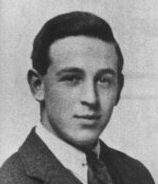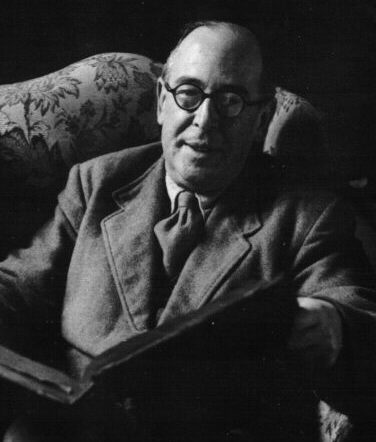Being a Historical Exploration of the Creation and Reception of the
Third Book of the Chronicles of Narnia
Biography of C. S. Lewis | Bibliographic Description of Original Text | Publication History
Contemporaneous Reception of Text | Critical Evaluative Essay | Home Page
 |
 |
| Photo
c.
1920s by Lewis's brother Warren |
Photo c. 1960 by Burt Glinn |
Clive Staples Lewis
b. November 29, 1898 in
Belfast, Ireland
d. November 22, 1963 in
Oxford, England
C.
S. Lewis was the second son of
Albert Lewis, a successful solicitor, and Florence Hamilton Lewis, the
daughter
of a rector in the Church of Ireland (Downing 2). His childhood home in
Belfast,
Little
Lea, was “a place of ‘long corridors, empty sunlit rooms, upstairs
indoor
silences [and] attics explored in solitude” (Lewis quoted in Downing
3). The
home also featured a “large, ornately carved oak wardrobe” in which C.
S.
(known to his family as Jack) and his older brother Warren played—a
furnishing
recognizable to readers of The Lion, the Witch, and the Wardrobe. The Lewis children also grew up hearing
Irish
folktales from their nurse Lizzie Endicott (Downing 5). Reportedly,
since the
age of 16 Lewis had the image of “a faun carrying parcels and an
umbrella in a
snowy forest” in his mind; this image would manifest itself in The
Lion,
the
Witch, and the Wardrobe (Sayer
188).
Lewis
was
a good student. He went
to boarding school at the age of nine, following his mother’s death. In
1916 he
won a classical scholarship to Oxford College. However, in April 1917
he
entered Officer Training and fought in the First World War in France.
On April
15 of 1918 he was wounded in the Battle of Arras and was evacuated back
to
England. In 1919 he returned to his studies at Oxford, where he earned
degrees
in classics, ancient philosophy, and English literature. Throughout the
course
of his studies he was interested in philosophy and spiritual matters,
dabbling in the occult,
Spiritualism, and atheism before becoming a theist Christian at the age
of 30
(Downing 18). After years of grappling with abstract philosophy, he
began to seek a more personal faith. He wrote to his friend Owen
Barfield, "Terrible things are happening to me. The 'Spirit' or 'Real
I' is showing an alarming tendency to become much more personal and is
taking the offensive, and behaving just like God. You'd better come on
Monday at the latest or I may have entered a monastery" (quoted in
Downing 18).
Lewis was a
very popular lecturer and fellow at Oxford College, but in addition to
his academic career he wrote many successful
essays, academic works, and works of fiction—though none would be as
popular as
the Narnia books. In 1929, after his conversion, he wrote the allegory The
Pilgrim’s
Regress, based on Bunyan’s Pilgrim’s
Progress. George Sayer describes The
Pilgrim’s
Regress as “a serious
book—primarily an attack on spurious satisfactions, false philosophies,
and
physical and spiritual temptations” that nonetheless “has a captivating
freshness” (136). The Pilgrim's
Regress is rarely written about by academics today, but remains
in print and popular with Christians. Throughout his career he would
show a similar knack for
handling serious matters with a relatively light hand. Lewis certainly
put this
ability to good use in writing the seven Narnia books, which were
published
between 1950 and 1956. Lewis won the Carnegie medal for outstanding
children's literature for The Last
Battle, the final Narnia book.
In
writing the Narnia books, Lewis
drew upon his own childhood memories and his religious beliefs. Another
inspiration for the story was the children who were evacuated to his
country
home at the beginning of World War II. (Many children who lived in
London were
sent to live with rural families to escape the heavy air raids.) Lewis,
who had
no children of his own, said the evacuated children “gave him a
newfound
appreciation for children” (Downing 29). A. N. Wilson suggested that
“Lewis
wrote them for the child who was within himself” (221). Wilson and
other
biographers believe that losing a
religious debate with the philosopher Elizabeth Anscombe in 1945
“was the single
greatest factor which drove him into the form of literature for which
he is
today most popular: children’s stories” (Wilson 211). However, David
Downing
notes, “Philosopher Richard L. Purtill has countered this thesis,
showing that
the famous debate was not the one-sided pummeling Wilson makes it out
to be and
that Anscombe herself didn’t think Lewis was particularly traumatized
by the
encounter” (30). The debate with Anscombe was regarding the claim Lewis
made in his book Miracles that
"
naturalism
is self-refuting
for it says that all our thoughts are ultimately traceable to the blind
working of chance and that no thought is valid if it can be fully
explained as the result of irrational causes" (Purtill). Lewis later
revised the chapter to address Anscombe's objections.
Lewis was
certainly inspired by the works of children’s
fiction written by his friends Owen Barfield and J. R. R. Tolkien.
Barfield and Tolkien were both members of the informal literary circle
Lewis dubbed the Inklings, which also included Lewis's brother Warren,
the novelist Charles Williams, and other Oxford-based friends. The
Inklings met weekly in Lewis's rooms and in a local pub and shared
their works in progress and offered critiques to each other.
The
Voyage
of the Dawn Treader, which
was published as the third of seven Narnia
books (but is the fifth in the series chronologically), was written
between
December 1949 and February 1950. Lewis drew inspiration for Dawn
Treader, which he called “a very
green and
pearly story,” from Homer’s Odyssey
and the medieval legend of St. Brendan (Downing 43). St. Brendan is an
Irish
saint who set sail from Ireland in search of the Land of Promise. After
seven
years, his crew finds the Land of Promise, but an angel tells them that
it
cannot be inhabited until it is given to the Blessed at the end of time
(Downing 44). This parallels the journey of Reepicheep and the three
British
children to the Utter East, the land of Aslan.
Like
all of the Narnia books, The
Voyage of the Dawn Treader has
parallels to
Christian theology. However, Lewis “almost certainly did not want his
readers
to notice the resemblance of the Narnian theology to the Christian
story”
(Sayer 192). Rather, Lewis said he was “aiming at a sort of pre-baptism
of the
child’s imagination” (quoted in Sayer 192). J. A. W. Bennett also
observes that
the novels
give
amusing insight into Lewis's prejudices—the initially odious behaviour
of
Eustace Scrubb, who first appears in The Voyage of the ‘Dawn
Treader’, is explained by the
fact that his parents are ‘up to
date and advanced people … vegetarians, non-smokers and teetotallers’,
three
things Lewis emphatically was not.
In a letter to a child,
Lewis wrote that The Voyage of
the Dawn Treader was about “the
spiritual
life (especially in Reepicheep)” (Downing 47). The Dawn
Treader’s voyage is both a
physical adventure story and a
metaphysical exploration.
One
final note: when discussing
Lewis’s personal history, it should also be noted that Lewis distrusted
source
criticism. Critics read his friend Tolkien’s Lord of the Rings as an allegorical warning about nuclear
warfare, but
the story was written well before Tolkien could have learned about such
weapons. Lewis “warned that source critics may expend so much ingenuity
in
‘getting behind the source text’ that they lose sight of the text
itself”
(Downing 32).
- Bennett, J. A. W. “Lewis, Clive Staples (1898–1963).” Rev. Emma Plaskitt. Oxford Dictionary of National Biography. Ed. H. C. G. Matthew and Brian Harrison. Oxford: OUP, 2004. Online ed. Ed. Lawrence Goldman. May 2008. 19 Sept. 2010.
- “C. S. Lewis." Contemporary Authors Online. Detroit: Gale, 2008. Literature Resource Center. 19 Sept. 2010.
- "C.
S. Lewis Images and Media." The Stone Table. Web. 1 December 2010.
- Downing, David C. Into the Wardrobe: C. S. Lewis and the Narnia Chronicles. San Francisco: Jossey-Bass, 2005.
- Green, Roger Lancelyn and Walter Hooper. C.S. Lewis: A Biography. San Diego : Harcourt Brace, 1994.
- Purtill, Richard. "Lewis, C. S. (Clive Staples) (1898–1963)." Encyclopedia of Philosophy. Ed. Donald Borchert. Vol. 5. 2nd ed. Detroit: Macmillan Reference USA, 2006. 311-313. 10 vols. Gale Virtual Reference Library. Gale. University of Illinois Urbana-Champaign. 19 Sep. 2010
- Sayer, George. Jack: C. S. Lewis and His Times. New York: Harper & Row, 1988.
- Wilson, A. N.. C.S.
Lewis: A Biography. New York : Norton, 1990.